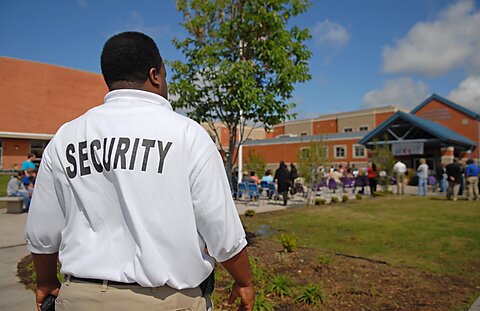The Costs of School Policing

Kayla Susalla
While public schools face ongoing funding challenges, resources are being allocated to School Resource Officers (SROs) to respond to anti‐social behavior. Though reactive measures are important to have in place, employing police to respond to misbehavior is not only costly, it does not provide a long‐term solution to school climate issues.
SROs are sworn law enforcement officers stationed in public schools, serving as first responders, mentors, and informal counselors. Research suggests their presence leads to increased out‐of‐school suspensions and arrests, affecting students of color, males, and those with disabilities at higher rates. Despite evidence highlighting the drawbacks of police in schools, their presence in public schools has been steadily increasing.
The State of SRO Spending
According to the Bureau of Justice Statistics, 4.3 percent of SRO program funding came from federal grants, 78.6 percent from school districts, and 10.2 percent from state or local grants, as well as taxes. Since the Columbine High School shooting tragedy in 1999, an estimated $1 billion has been distributed by the federal government, and $965 million in state funding. The US Department of Justice’s Community Oriented Policing Services (COPS) office currently distributes grant money to police agencies to help fund SRO programs. States spending more per pupil on SROs tend to spend less on counselors, nurses, social workers, and psychologists.
Proposed Additional Funding
In the 2023–24 legislative session, the Strengthening School Safety for Security Act was introduced, which would penalize states by withholding federal education funds if they did not possess two SROs per 500 students in each elementary and high school. The act would allocate $28 billion over four years. Another bill, the Safe Schools Act, would distribute funds originally intended for COVID-19 relief to hire SROs and add other security measures.
Given the limited, mixed research on SROs, and literature suggesting they largely respond to non‐deadly crimes, there is concern that school policing over‐criminalizes trivial misbehavior that could be handled by schools. Constitutionally, the federal government has no authority to intervene in education, and it should especially avoid funneling unprecedented dollars to programs that do not produce a net benefit.
It is also unclear if anti‐social behavior in schools calls for large increases in law enforcement. A common justification for employing SROs is to respond to violent fights, yet data suggest fighting in high schools, where SROs are most concentrated, has shown a declining trend since 1993.
The Cost of Juvenile Criminal Justice Involvement
If the juvenile’s case continues through court processes, families can accumulate high lawyer and court fees. Officers can also issue a citation in lieu of formal processing. But heavy‐hitting costs have been shown to increase recidivism, and it’s unreasonable to place large financial responsibilities on minors, who may not even be employed. Such policies could also cause financial strain on families.
When cases advance to incarceration, taxpayers, and in some states parents, get the bill. The chart below illustrates the high costs of adolescent imprisonment by state.
Juvenile Economic Exclusion
Beyond the pecuniary costs are the narrowing of opportunities to increase individual capital.
Juvenile records create lasting barriers to education opportunities, as college admissions processes often ask applicants to disclose criminal histories, including arrest records. Today, if a juvenile is incarcerated, they are ineligible for federal student loans, depriving them of a chance to dramatically increase their lifetime earnings.
As of 2021, only 22 states had automatic expungement laws for juveniles, and some require initiation from prosecutors or judges. Juveniles with records are half as likely to receive a call‐back from an employer. A fight at school should not equate to a lifetime sentence for economic exclusion.
Alternatives to School Policing
Community‐centered alternatives should be prioritized, as they have been shown to produce positive outcomes and are less costly for the individual and their families, as well as taxpayers. Mentoring programs such as Big Brothers Big Sisters America have demonstrated constructive results by reducing juvenile drug and alcohol use and physical altercations, while improving peer and familial relationships.
Another program, Positive Family Support (PFS), engages parents in school by hosting behavioral interventions and facilitating actionable plans for correction. PFS has been shown to decrease substance use and anti‐social behavior.
Further, students in violation of school rules could be tasked with cleaning cafeterias or locker rooms, while engaging with a teacher or other staff member. Practices would strengthen relationships between adults and children, making it more plausible for students to reach out to a trusted adult in times of need, as well as facilitate trust, promoting greater receptivity to behavior‐correcting interventions. As the teen mental health crisis remains a pressing issue, policies strengthening community ties and keeping kids in school are more important than ever.
Conceptualizing the consequences of one’s behavior is a part of the maturation process, and harsh punishments leading to long‐term consequences do not provide kids with needed coping and conflict‐resolution strategies.
For many reasons—financial and personal costs, as well as constitutional prohibitions—the federal government should get out of SRO funding, and states and school districts should think long and hard about expanding the presence of SROs.





